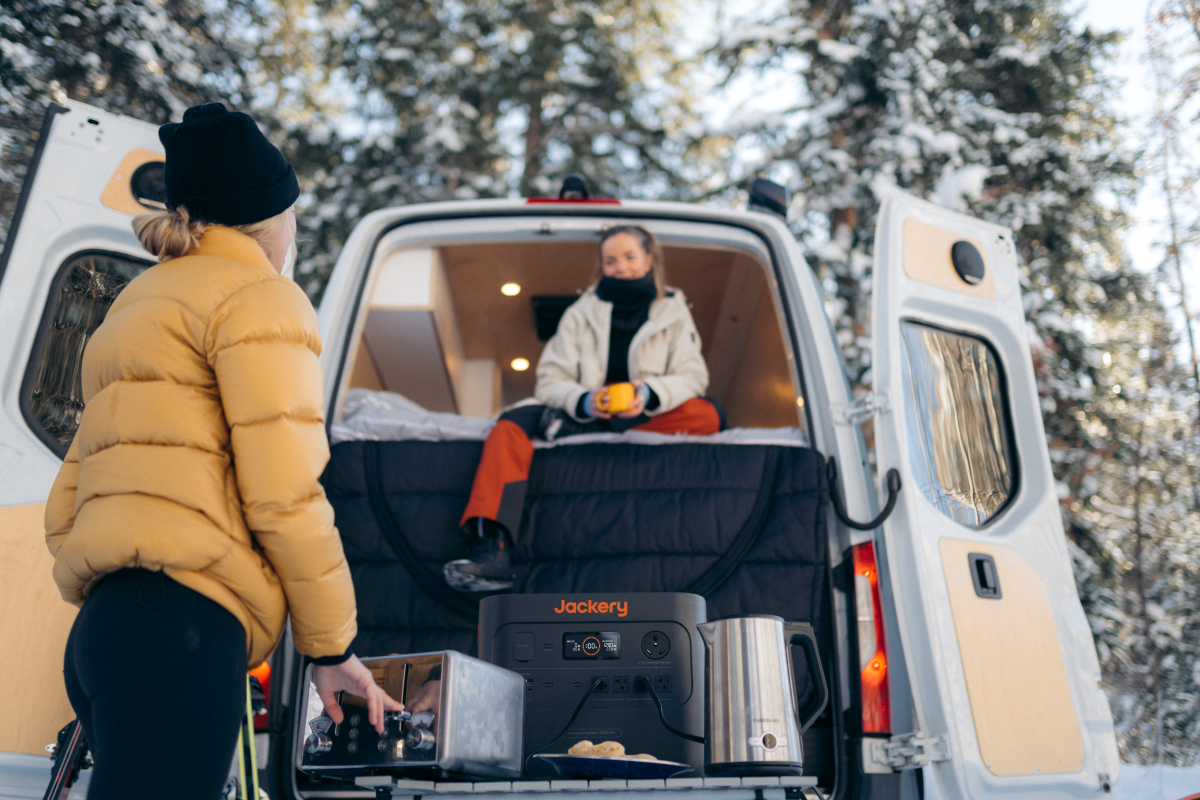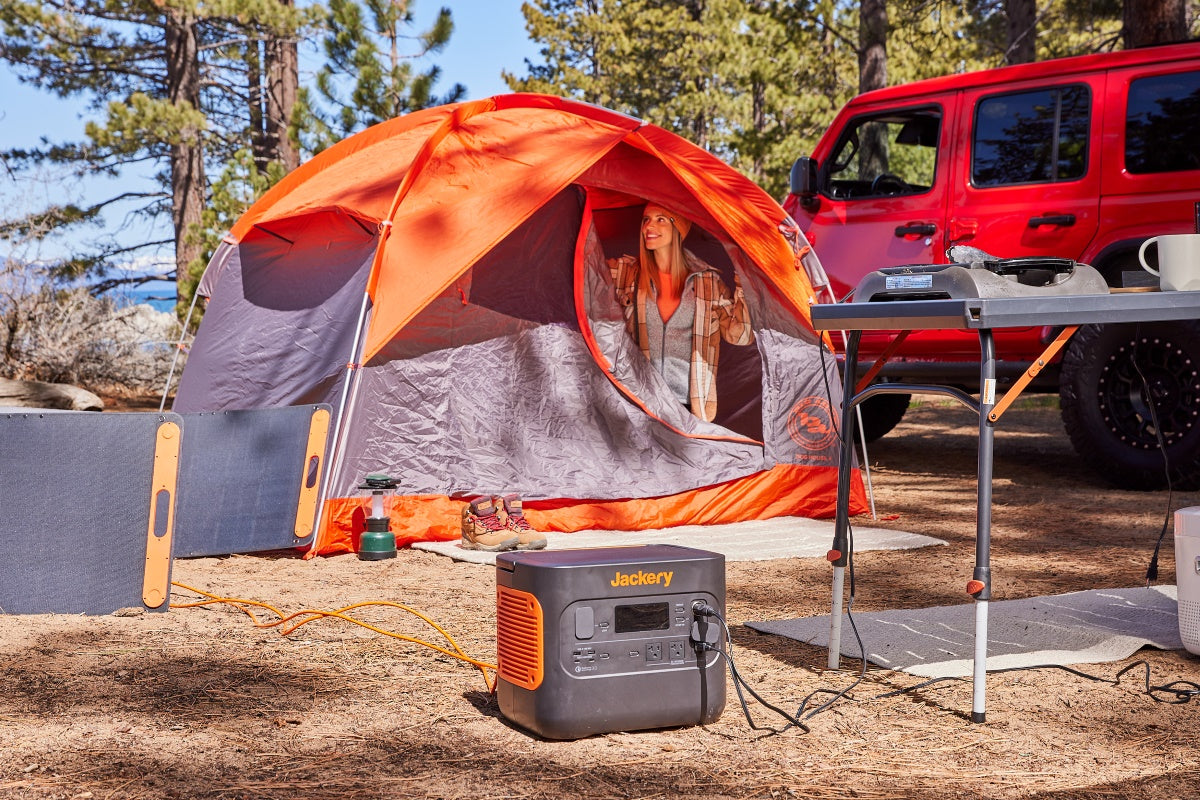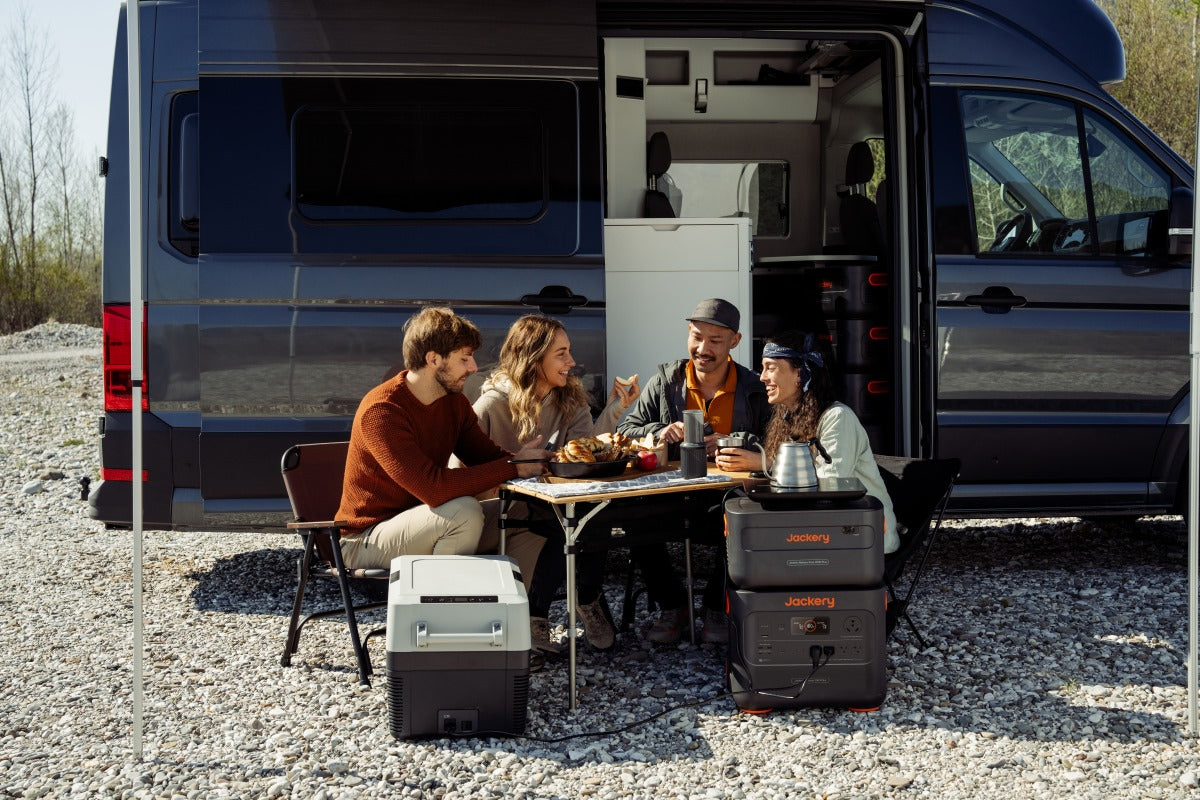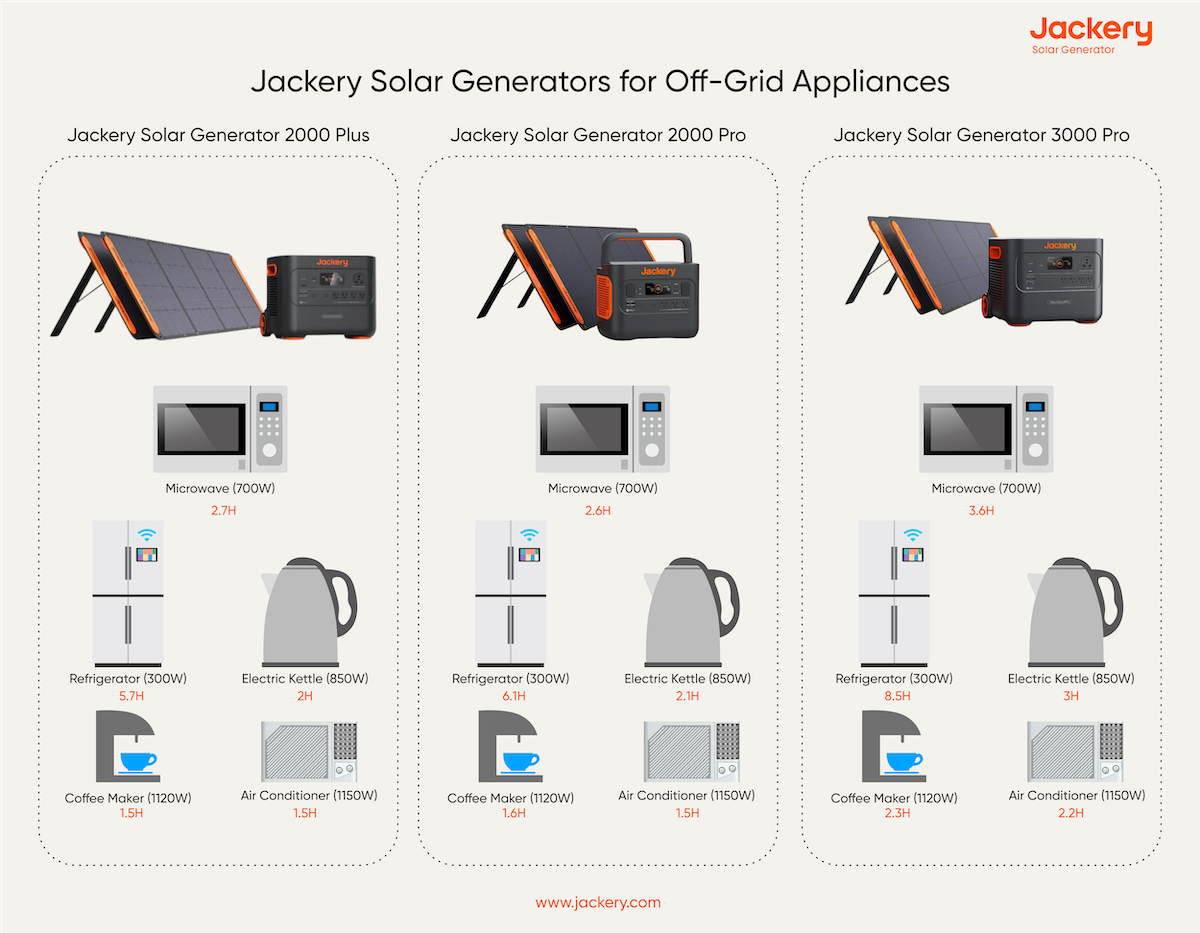Living off-grid is the perfect escape from the chaos of urban life and enjoying a sustainable, self-sufficient lifestyle. Switching from a traditional to an off-grid lifestyle will help you reconnect with what matters – freedom, nature, and family.
But let's be honest; living off the grid isn't all sunshine and rainbows. You must work, develop skills, and have the right resources to make your dream come true. So, how to live off the grid? First things first, you need a reliable power source to live independently.
Jackery Solar Generators are among the most efficient and powerful off-the-grid solar systems. They consist of SolarSaga Solar Panels and Explorer Portable Power Station to convert sunlight into electricity and power appliances.
The popular off-the-grid battery backups include Jackery Solar Generator 2000 Pro and Jackery Solar Generator 3000 Pro with high-capacity NMC batteries of 2160Wh and 3024Wh, respectively. In addition, the expandable Jackery Solar Generator 2000 Plus features a LiFePO4 battery of 2042.8Wh capacity, making it an ideal choice for powering appliances while living off the grid.
|
Products |
Image |
Capacity |
Rated / Peak Power |
Battery |
Size |
|
 |
3024Wh |
3000W (6000W Peak) |
NMC |
Length: 18.6 in (47.24 cm) Width: 14.1 in (35.81 cm) Height: 14.7 in (37.36 cm) |
|
|
 |
2160Wh |
2200W (4400W Peak) |
NMC |
Length: 15.1 in (38.4 cm) Width: 10.5 in (26.9 cm) Height: 12.1 in (30.75 cm) |
|
|
|
2kWh to 24kWh |
3000W (6000W Peak) |
LiFePO4 |
Length: 14.7 in (37.36 cm) Width: 18.6 in (47.3 cm) Height: 14.1 in (35.94 cm) |
What Does Living Off The Grid Mean?
Technically, off-the-grid living means disconnecting your home electrical connection from the local power grid. You need your own power source to charge mobile phones and run home appliances like refrigerators, AC, heaters, etc., especially when you are away from the grid.
People wanting to be self-sufficient and live in harmony with nature often choose off-grid living. That means they will focus on generating their own power using solar, wind, or hydropower systems.
However, it's important to note that off-grid homesteaders do not isolate themselves from society. On the contrary, the primary goal behind living off the grid is to reduce reliance on public utilities and live a sustainable life. In this section, we will discuss the pros and cons of living without a grid connection.
Why Choose To Live Off The Grid?
Global warming is turning cities into ovens, making people adopt the off-grid lifestyle to protect the environment. In addition to reducing environmental impact, it helps lower your high utility bills. Below are a few more reasons to live off the grid.
- Low Carbon Footprint:Living off the grid means you rely more on renewable energy and less on non-renewable. Sustainable practices help you produce less waste and be self-sufficient.
- Reduce Stress and Anxiety:Connecting with nature will help you feel relaxed and less stressed. This way, you can improve your mental and physical health.
- Boost Confidence:Learning new problem-solving skills to survive without public utilities boost confidence and improves self-sufficiency.
- Minimalism:Cutting the connection from modern power sources and choosing renewable sources involves simplifying one's life and possessions, leading to a greater sense of fulfillment and purpose.
Pros And Cons Of Living Off The Grid
Before you understand how to live off the grid, it's vital to understand the advantages and drawbacks of the lifestyle. Weighing the pros and cons carefully will help you make a quick decision.
Here is a quick breakdown of the pros and cons of an off-grid lifestyle.
|
Pros |
Cons |
|
Save money |
High initial costs |
|
Sustainable lifestyle |
Lots of work is involved |
|
Protection from power outages |
|
Pros
- Save Money:Electricity prices are soaring, forcing people to look for alternative power solutions. Living off-grid will help you save money and reduce the costs related to utility, food, and general consumption.
- Sustainable Lifestyle:As it helps you lower the carbon footprint, it is an eco-friendly lifestyle.
- Protection From Power Outages:When you use electricity from the grid, you are entirely dependent on it. You are left in the dark when the power goes out. Transitioning to off-grid living will wash away the worries about power outages.
Cons
- High Initial Cost:Setting up your energy source, water supply, and waste disposal will require a high initial expense.
- Lots of Work is Involved: When you go for an off-grid living, you have to do a lot of work, like maintaining power and water sources.
Proper planning will help you make your off-the-grid living experience more comfortable.
What Are The Types of Living Off The Grid?

Going off the grid can help you become more independent and less reliant on public utilities. Here are a few different types of living off the grid.
Extreme
Extreme off-grid living always comes out of dire circumstances. For instance, when wildfires in California led to the destruction of homes, people found themselves living off the grid.
Also known as "roughing it," the extreme lifestyle means living in a shelter without access to standard electricity hookups or running water. In this case, you will have to look for a potable river or lake nearby.
For power or electricity sources, you can use a solar generator to harness the power of solar energy for charging the appliances. It is the cheapest yet most challenging type of off-grid living.
Partial
Unlike extreme off-grid living, partial off-grid living is the most comfortable and attainable type for most people. Its primary aim is to significantly reduce dependence on municipal resources while improving self-sufficiency.
In this case, you will have a septic system rather than connecting with a public sewer system. Similarly, instead of using electric heaters, you will use wood burners to heat your home during chilly winters.
Modern
One of the most popular off-the-grid methods suitable for off-grid enthusiasts is modern living. Not only can you enjoy modern conveniences, but you can also implement ways to remain self-sufficient. Even though the initial cost of contemporary living is high, you can reduce your expenses over time.
Also known as fully off-grid living, it allows you to have a variety of power sources, modern amenities, and clean water. People living in the contemporary off-grid style use modern appliances for cooking food. Some people even opt for raising livestock and cultivating their own food.
|
Pros |
Cons |
|
|
Extreme |
● It is the cheapest way to live off-grid. |
● It is the most challenging. |
|
Partial |
● It is most comfortable and attainable for the majority of people. ● It reduces dependence on local resources. |
● You'll still have to pay some bills. |
|
Modern |
● It is the most popular option for living off the grid. ● It helps you learn self-sufficiency. |
● You'll be required to invest in power or water systems beforehand. |
Living Off The Grid Essentials
In its most basic context, living off-grid requires you to procure four essential elements: shelter, power, water, and food.
Shelter
When it comes to answering "how to live off-grid," the first important thing you must look for is a reliable shelter. An RV, a cabin in the woods, or a tiny home away from civilization can act as an ideal off-grid home.
Power
Now comes the most crucial thing – power – that will help you to heat your space in winter, cook food, and communicate with your loved ones. Solar-powered generators are the most reliable powering sources for off-grid electrical appliances.
A portable and lightweight Jackery Solar Generator allows you to generate power whenever and wherever you need it. The solar-powered system consists of foldable solar panels and a high-capacity power station.

Jackery Solar Generator 2000 Pro, Jackery Solar Generator 1500 Pro, and Jackery Solar Generator 1000 Pro are some of the most popular choices for off-grid enthusiasts.
Water
Next, you need to ensure you have easy access to a steady stream of potable water for bathing, drinking, and cleaning. You can choose a location with nearby underground water, stream, or river. However, you have to invest in a central filtration system to purify water before using it.
Food
When you truly go off-grid, you will have to focus on gardening, foraging, farming, and fishing. Many people prefer growing and harvesting their own food to become self-sufficient, while many others stock up large quantities of dry goods and non-perishable food items as a backup.
Remember, off-grid living is all about being self-sufficient in the outdoors. Planning prior to going off-grid will help you avoid any unanticipated consequences.
How to Live Off The Grid?
If you want to live off the grid, all you need to do is move to the woods, construct a cabin, invest in a solar power system, and drill a well. While it may sound simple, it takes proper planning, appropriate preparation, and work to move off-grid. Here's how to live off-grid.
Purchase Land for an Off-Grid Home
The first thing you need to do is choose the land for your off-grid life. That usually means having land in any remote area that is far from permitting regulations and strict building codes. Such lands are generally less expensive and have lower property taxes. While looking for land, here are a few things you must check.
- Soil Quality:If you want to grow your own food, make sure the property has good-quality soil and enough space for greenhouses or raised beds for optimal growing conditions.
- Sun Exposure:Those planning to invest in a solar power system must ensure the land gets enough sun exposure. Avoid buying land that is covered with other structures and obstructs direct sunlight.
- Legal Requirements: Living off-the-grid has legal implications, so you need to understand zoning regulations, building codes, and local laws.
Build or Buy an Off-Grid Home
There are two options to live off-grid: either buy a rural home or build an off-grid house from scratch. If you are purchasing an already built home, contact realtors to visit homes and see how easily you can convert it to off-grid. If a fixed home isn't your choice, consider a camper or modern RV with kitchens, bedrooms, and bathrooms.
Install a Solar Power System
An off-grid home needs a reliable solar power system with a battery backup and a few solar panels. There are three main types of solar power panels: monocrystalline, polycrystalline, and thin film. They differ in terms of efficiency and the material used to construct them.
- Monocrystalline silicon solar cells make the most highly efficient solar panels and convert the maximum sunlight that falls on them.
- Polycrystalline has lower efficiency than monocrystalline but more than thin-film panels.
- Thin-film solar panels have the lowest efficiency and cheapest cost, making them less ideal for most use cases.
Some houses have solar panels tied to the electrical grid, meaning the generated energy goes to centralized grid systems. On the other hand, an off-grid solar system consists of solar panels and a battery backup that is attached together to power off-grid electrical devices. The off-grid system remains independent from the primary electricity grid, so you don't have to worry about power outages.
Jackery Solar Generators combine portable Jackery Explorer Portable Power Stations and Jackery SolarSaga Solar Panels that work in tandem to generate power for off-the-grid living. These solar panels are built with monocrystalline silicon solar cells that have the highest efficiency and conversion rate. In addition, these power stations have LiFePO4 or NMC batteries that store the electricity generated to power any appliance.

Water System
A clean power source is ideal for an off-grid home. Since you'll not have access to municipal water sources or city water, you must choose a land with a natural water source. A well is one of the best but expensive options where the price increases with the drilling depth. Once the well is drilled, the cost of maintenance is low, and you can get healthy, mineral-rich water.
Heating & Cooling
Heating and cooling the off-grid house relates to power generation. Your needs will depend on the home size and climate of the place. Passive heating is one of the best ways to regulate the temperature of the home without draining the power source. For example, you can use some natural methods like insulation, optimal window placement, shading, and ventilation to reduce your reliance on energy-intensive heating and cooling systems.
Waste Disposal
In your off-grid home, you'll have to deal with waste disposal. A traditional septic system or some sort of composting waste disposal system installed by following local and federal guidelines could be a great option. Composting toilets are one of the highly efficient options out there, especially for tiny homes. Septic tank systems are robust and permanent wastewater management systems widely used in rural areas and typically last for years.
Grow Your Own Food
You must learn how to grow your own food while living off the grid. You can start a garden and then use the drip irrigation method to water it. Anywhere around 4000 square feet of growing space is enough to feed one person for one year. While choosing the plants to grow in your garden, check the area's climate and choose a place that is well-drained and gets at least 6 hours of sunlight.
Communities and Resources
There are many times when living off the grid can be lonely. Fortunately, there are a lot of great options out there, such as community living spaces and communes, where you can find more off-grid people.
Jackery Solar Generators for Off-Grid Living
If you've decided to live off-grid, you'll need the right tools to stay comfortable. First, you need a home battery backup that can power all the essential appliances like refrigerators, coffee makers, TVs, smartphones, and more. As a general rule of thumb, portable solar generators are best for charging small or large appliances in your off-grid home. The larger the solar generator, the more appliances it can power for long hours.
Jackery Solar Generators are powerful and portable battery backups to charge your off-grid appliances. They combine Jackery Explorer Portable Power Stations and Jackery SolarSaga Solar Panels, where the solar panels collect the sun's rays to generate DC current. The pure sine wave inverter in the portable power station then transforms the DC to AC electricity. Then, you can plug appliances directly into the unit to power them.
Jackery Solar Generator 3000 Pro
If you want to charge 99% of off-grid appliances, the Jackery Solar Generator 3000 Pro makes more sense. It has an NMC battery of 3024Wh capacity that can be charged in 3.5 hours via 6*Jackery SolarSaga 200W Solar Panels, 2.4 hours via an AC adapter, and 35 hours via a car charger. The pull rods and double wheels of the solar generator make it easy to carry from one place to another. In addition, it features a unique quiet canyon cooling system that ensures the Jackery Explorer 3000 Pro Portable Power Station emits only 30dB of noise during operation.

Customer Review
"Purchased to run the fridge and upright freezer if the power goes out. It is to be used at night with no noise or fumes. I can run both for about 22 hours on a full charge. I also ran multiple lights, a sound bar, and a miter saw with plenty of room for more." — T. Wooding.
|
Product |
|
|
Capacity |
3024Wh |
|
Battery Cell |
NMC |
|
Dimension |
Length: 18.6 in (47.24 cm) Width: 14.1 in (35.81 cm) Height: 14.7 in (37.36 cm) |
|
Noise Level |
Less than 30dB |
|
Recharging Methods |
Solar Recharging: 3.5 H (6*Jackery SolarSaga 200W Solar Panels) Wall Recharging: 2.4 H Car Recharging: 35 H |
|
Output Ports |
AC Output (x1): 120V~ 60Hz 25A Max AC Output (x3): 120V~ 60Hz 20A Maximum USB-C Output (x2): 100W Maximum, 5V⎓3A, 9V⎓3A, 12V⎓3A, 15V⎓3A, 20V⎓5A |
Jackery Solar Generator 2000 Pro
Next on the list is the Jackery Solar Generator 2000 Pro with an NMC battery of 2160Wh capacity and a 2200W pure sine wave inverter. It has superior fast solar and AC charging ability, meaning you can power via an AC outlet in 2 hours. With 6*Jackery SolarSaga 200W Solar Panels, you can charge the Jackery Explorer 2000 Pro Portable Power Station in under 2.5 hours. The off-grid power station features high-temperature protection and heat dissipation for high durability. Once fully charged, the battery backup can safely power 96% of your electrical devices.

Customer Review
"Peace of mind knowing we have a backup in the event of a power failure. A very nice, powerful unit that is super easy to use and fast charging. Have powered several appliances in the house. I have recently purchased a second Jackery Explorer 2000 Pro to alternate with the first when recharging is required. We are now prepared for an emergency." — Richard W.
|
Product |
|
|
Capacity |
2160Wh |
|
Battery Cell |
NMC |
|
Dimension |
Length: 15.1 in (38.4 cm) Width: 10.5 in (26.9 cm) Height: 12.1 in (30.75 cm) |
|
Noise Level |
30dB |
|
Recharging Methods |
Solar Recharging: 5.5 H (6*Jackery SolarSaga 100W Solar Panels) Wall Recharging: 2 H Car Recharging: 24 H |
|
Output Ports |
AC Output (x3): 120V, 60Hz, 2,200W (4,400W Surge Peak) USB-A Output (x2): Quick Charge 3.0, 18W Maximum USB-C Output (x2): 100W Maximum, (5V, 9V, 12V, 15V, 20V up to 5A) |
Jackery Solar Generator 2000 Plus
While both of the previously mentioned solar generators feature NMC batteries and cannot be expanded, the Jackery Solar Generator 2000 Plus has a LiFePO4 battery. It can be extended from 2kWh to 24kWh with the help of Jackery Battery Pack 2000 Plus. Similar to the other solar generators, the Jackery Solar Generator 2000 Plus can be charged via 6*Jackery SolarSaga 200W Solar Panels in 2 hours, an AC outlet in 2 hours, and a 12V car adapter in 25 hours.

Customer Review
"I purchased this for my camping needs when power is not available at campsites for use with my Class A, Pop-up, and truck camping. To date, I have only used it with my Class A, which has an on-board gas generator (which is not usable during quiet hours at parks). The Jackery Solar Generator 2000 Plus powered me through the night with heat and general lighting with power to spare the following morning." — Chris K
|
Product |
|
|
Capacity |
2 kWh to 24 kWh |
|
Battery Cell |
LiFePO4 |
|
Dimension |
Length: 14.7 in (37.36 cm) Width: 18.6 in (47.3 cm) Height: 14.1 in (35.94 cm) |
|
Noise Level |
Less than 30dB |
|
Recharging Methods |
Solar Recharging: 2 H (4*Jackery SolarSaga 200W Solar Panels) Wall Recharging: 2 H Car Recharging: 25 H |
|
Output Ports |
AC Output (×4): 120V~ 60Hz, 20A Max AC Output (×1): 120V~ 60Hz, 25A Max USB-A Output (x2): Quick Charge 3.0, 18W Max USB-C Output (x2): 100W Max, (5V, 9V, 12V, 15V, 20V up to 5A) |

How to Live Off The Grid FAQs
Choosing off-grid as your new lifestyle does not have to be daunting. If you are still perplexed about how to live off the grid, here are a few frequently asked questions.
How much money do you need to live off-grid?
The exact cost of living off the grid will depend on the location, quality, and scale of utility systems and the level of self-sufficiency. On average, the cost of buying any land, building an off-grid house, and buying utilities amount to $50,000 to $150,000. Remember, the main elements where you'll need to invest your money include land, shelter, water, electricity and heat, and sewers.
If you already have a home, the next step is to invest in a portable battery backup like Jackery Solar Generator. For example, the cost of the Jackery Solar Generator 3000 Pro (Jackery Explorer 3000 Pro Portable Power Station + 2*SolarSaga 200W Solar Panels) is $3,999. With the off-grid battery backup, you can charge appliances with free solar energy.
Here is an estimated breakdown of the costs required to live off the grid.
|
Cost |
Low |
Average |
High |
|
Land |
$2000 |
$20,000 |
$200,000 |
|
Housing |
$500 |
$50,000 |
$250,000 |
|
Power |
$8000 |
$35,000 |
$70,000 |
|
Cooking/heating |
$100 |
$300 |
$3000 |
|
Water |
$1500 |
$9000 |
$15,000 |
|
Septic tank |
$3000 |
$5000 |
$10,000 |
|
Garden |
$1200 |
$3500 |
$10,000 |
|
Total |
$16,300 |
$122,800 |
$558,000 |
Is it legal to live off the grid in the United States?
It is technically not illegal to start off the grid living in any state in the United States. However, there are specific regulations in different parts of the nation that you must keep in mind while setting up your off-grid house. For example, in some places, you need a special permit to build wells and septic tanks.
How do beginners live off the grid?
If you are a beginner and wish to live off the grid, the first step is to learn essential skills like cooking, carpentry, and gardening. You can even join an existing off-grid community at sustainable projects to gain practical experience and reduce costs during the transition period. If you don't wish to live in an existing community, consider learning natural building techniques to construct an off-grid home, explore renewable energy sources, and grow your own food.
Is living off-grid healthier?
Yes, living off-grid seems a healthier choice compared to modern living. From working overtime at jobs to expensive rent in cities, everyday living can be stressful. Off-grid living is like taking a step back and returning to our roots. Here are a few benefits of living off the grid.
- Living off the grid helps you learn how to be self-sufficient, from growing your own food to producing your own electricity and even building your own shelter.
- It's an act to disconnect from the stress of modern living and spend time with nature. When living off-grid, the relaxing environment of nature becomes your neighbor.
- Off-the-grid livingis challenging, especially during extreme weather conditions and wildlife occurrences. In this type of living, you can only rely on yourself and get an epic sense of pride.
Final Thoughts
Now that we have covered how to live off the grid in detail and the essentials required, you are set to embark on your new off-grid journey.
Investing in an off-the-grid solar system is one of the best ways to make your off-grid living less stressful and thrilling. Not only can you cut off your high utility bills, but you can also enjoy an independent and sustainable life.
Jackery Solar Generators are one of the ideal solar-powered solutions that can help you charge most small and large appliances. It is easy to set up and an eco-friendly solution for powering home and outdoor devices, so you never have to worry about power.
Don't forget to sign up for the Jackery newsletter to get the latest product news, promotional offers, and other information in your inbox.
Don't forget to sign up for the Jackery newsletter to get the latest product news, promotional offers, and other information in your inbox.







































![[Add - on] Jackery Manual Transfer Switch for Explorer 5000 Plus - Jackery](http://www.jackery.com/cdn/shop/files/add-on-jackery-manual-transfer-switch-for-explorer-5000-plus-9017324.png?v=1754016782&width=170)





























































































Leave a comment